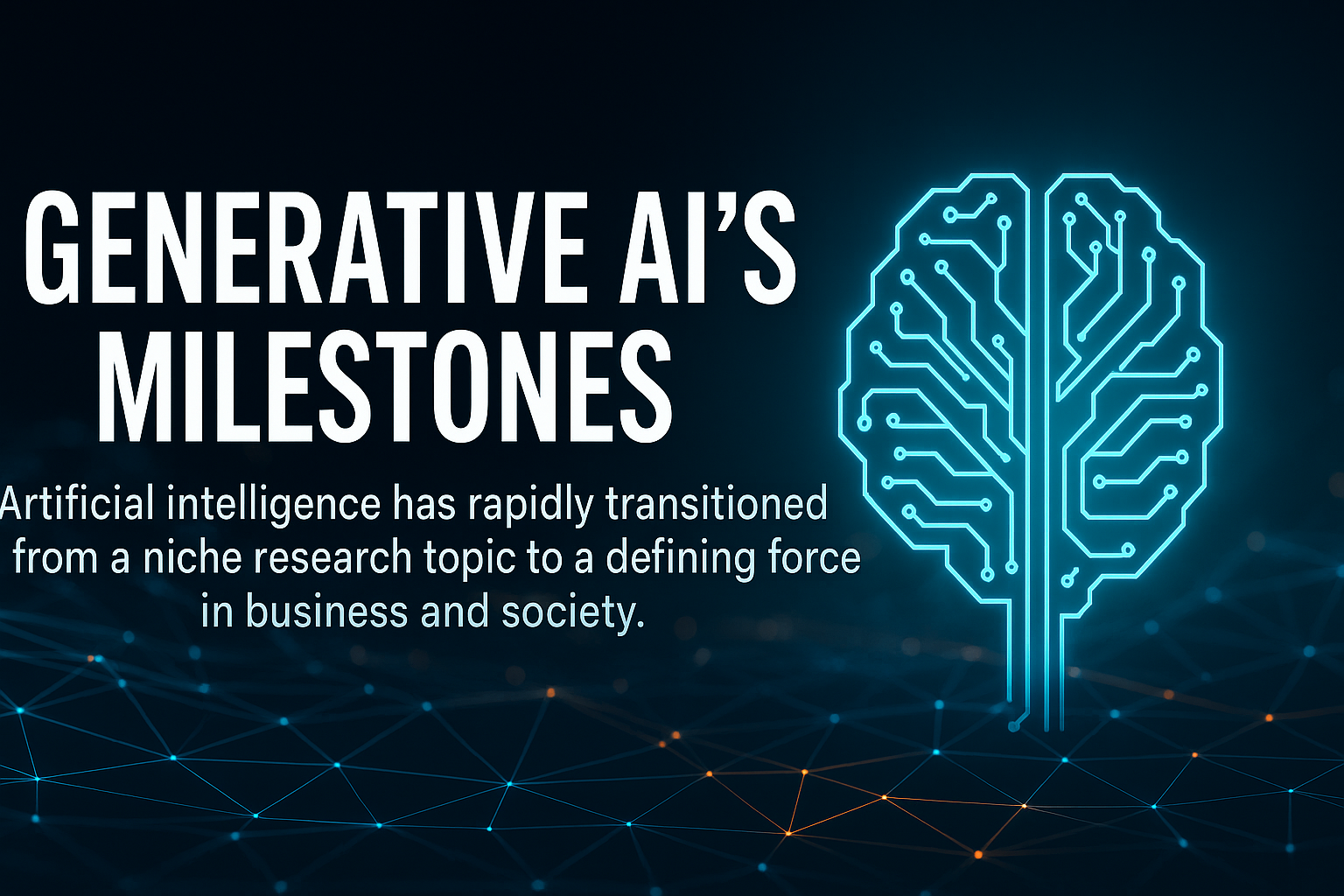Artificial intelligence has rapidly transitioned from a niche research topic to a defining force in business and society.
In just a few years, generative AI – systems like OpenAI’s ChatGPT (launched Nov 2022) and Google’s Gemini – has gone mainstream, captivating the public imagination and enterprise alike. Corporations now routinely experiment with AI for customer service, marketing, coding assistance and more. McKinsey & Company reports that roughly 65% of companies are now using generative AI in at least one function, nearly double the share from a year earlier. Similarly, PwCforecasts that AI could contribute $15.7 trillion to global GDP by 2030, driven by productivity gains and new products. These statistics underscore that we may be at the dawn of a technology that transforms industries and economies. Yet, this is only the first act. Industry leaders and researchers increasingly talk about Artificial General Intelligence (AGI) – AI that matches or exceeds human cognitive abilities across tasks – as the horizon. OpenAI CEO Sam Altman now openly says the company is “confident [it knows] how to build AGI” and expects the first AI agents to “join the workforce” by 2025. Google’s co-founders share this urgency: Larry Page once described AI as “the ultimate version of Google…what we work on”, and Sergey Brin recently told his AI team that “the final race to AGI is afoot” and Google must “turbocharge our efforts” to win it. From Silicon Valley to Beijing, a global chorus of visionaries is proclaiming that AGI is coming – and fast.
Generative AI’s Milestones
In practice, we’ve already seen astonishing breakthroughs in generative AI. OpenAI’s GPT-4 (released Mar 2023) can write coherent essays, debug code, and tutor students. Its sibling ChatGPT popularized the conversational AI assistant. Google’s Gemini series has rapidly iterated (Gemini 1.0 in 2023, Gemini 1.5 in early 2024) with ever-expanding context windows and multi-modal abilities. Anthropic’s Claude and Meta’s LLaMA models now compete on capabilities. OpenAI recently debuted Sora, a text-to-video model that creates rich video scenes from natural-language prompts. Every few months brings new models with more parameters, better reasoning, and novel modalities (images, video, voice). This flood of powerful tools – ranging from public APIs to private large models – is reshaping how companies operate. Internal AIs can draft marketing copy, analyze data, and even design products. A survey finds marketing, sales, and R&D are the fastest-growing users of gen-AI, reflecting its ability to accelerate knowledge work. Key milestones include ChatGPT’s launch (November 2022), the rise of commercial AI chatbots like Google Bard, and massive advances in model size and training data. Generative AI’s public debut exploded expectations – within days of its launch, ChatGPT claimed over a million users, catching even investors by surprise. Tech giants quickly responded with their own offerings. Behind the scenes, countless R&D teams worked furiously. For example, China’s DeepSeek AI startup built a DeepSeek-R1 reasoning model at a fraction of the cost of Western counterparts, signaling a “we’re done following, it’s time to lead” mentality. In short, we are witnessing a catalytic leap: from narrow “analytical AI” to broad generative AI that can write, create, and solve novel problems on demand.
Voices of the AI Vanguard
What do the architects and founders of AI say about this moment? Their words paint a picture of both opportunity and urgency. Sam Altman of OpenAI stresses that AI progress is exponential and global. He writes that by 2025 we may see “AI agents [join] the workforce” and materially change company output, affirming OpenAI’s belief that AGI as traditionally defined is within reach. Altman emphasizes that iteratively deploying powerful tools tends to drive “broadly-distributed outcomes.” DeepMind’s Demis Hassabis is equally optimistic about benefits: if AGI is “done properly and responsibly, it will be the most beneficial technology ever invented,” enabling us to cure diseases, solve climate change, and achieve “maximum human flourishing”. As Hassabis vividly puts it, in an optimistic future “we’ll be in this world of maximum human flourishing, traveling the stars” thanks to AI. He has warned that getting AI wrong could be chilling, but insists that if built correctly it will act like the “cavalry” for our most pressing problems. Beyond these high-profile founders, innovators worldwide are staking bold claims. Liang Wenfeng, a millennial entrepreneur in China, vows to leapfrog Western AI by prioritizing innovation over copying. His startup DeepSeek lowered prices on its GPT-like services to democratize AI, and he candidly declares: “Our goal is still to go for AGI”. Liang sums up his generational stance: “We’re done following. It’s time to lead”. Across the Pacific, Aravind Srinivas, CEO of AI startup Perplexity, has been preaching that AI will soon be ubiquitous. In a viral post he warned bluntly that “AI will run your life whether you like it or not. That’s where things are clearly headed”. His co-founder Denis Yarats echoes this vision: Perplexity is built on the premise that search engines will evolve into assistant agents. Yarats predicts an era where AI no longer just returns ten links, but executes tasks for users (booking travel, tutoring, business analytics, etc.), requiring new infrastructure beyond traditional search. Even big tech pioneers are doubling down on AI. Google’s co-founder Larry Page famously envisioned an “ultimate” search engine that understands the web – essentially AI – and framed it as Google’s mission. His fellow co-founder Sergey Brin has taken a more visceral approach, reportedly telling Google’s Gemini team that “the final race to AGI is afoot,” and urging engineers to work “60 hours a week” as the “sweet spot” to win it. He insisted that Google has “all the ingredients to win this race” but must “turbocharge our efforts”. At IBM and elsewhere, executives similarly speak of AI as transformational, promising “AI agents” that assist employees. In sum, the chorus from leaders is clear: AI’s capabilities are accelerating, and the quest for AGI has moved from sci-fi to corporate strategy.
The Business and Economic Boom
The promise of AI has not gone unnoticed in boardrooms. Businesses are already moving fast to capture value. According to McKinsey, about 65% of organizations report regularly using generative AI in some capacity – a surge from roughly one-third a year earlier. Companies say they’re finding both cost savings and new revenue: marketing departments use AI to draft campaigns, R&D teams accelerate design processes, and customer support bots handle routine inquiries. The top use cases are in marketing/sales and product development, consistent with studies showing those functions could see the largest productivity gains. For example, one survey found that AI use can cut up to 30% of time spent on certain knowledge tasks, effectively giving workers “supercharged” assistance. Economists project this productivity surge will be enormous. A PwC analysis estimates that AI could boost global GDP by $15.7 trillion by 2030 – roughly a 14% increase over business-as-usual. Much of this comes from efficiency improvements (automating routine work) and product innovations (services that didn’t exist before). China and North America are forecast to see the biggest GDP boosts, on the order of 20–26% by 2030. In plain terms, entire industries could be reshaped: healthcare could see AI-aided drug discovery; finance could see smarter risk modeling and robo-advisors; manufacturing could become highly automated with AI-driven robots. Already, companies like The Coca-Cola Company, Goldman Sachs, BMW Group, and many startups are piloting generative AI applications. The transformation is not just theoretical – it’s happening now. These disruptions also raise competitive stakes. As DeepMind’s Hassabis notes, nations and companies possessing the largest compute resources (and thus the capacity to train huge models) have an edge. Google, Microsoft (OpenAI), and Chinese giants like Alibaba Group and Baidu, Inc. are all racing to train bigger, smarter systems. Even venture-capital–backed startups like Perplexity have secured billion-dollar valuations based on rapid adoption of their AI products. The level of investment and attention today rivals past revolutions (like mobile or the internet). In essence, generative AI is eating the world – it’s being integrated into CRM systems, coding platforms, content moderation, legal research, and more. Any business that relies on information processing is scrambling to adapt or risk falling behind.
Breakthrough Products and Platforms
Some names stand out as landmarks on this journey. ChatGPT (GPT-4) is a household name, the first mass-market AI assistant. Google Bard/Gemini shows how Google has rebranded its AI efforts around a more capable model. Claude (by Anthropic) and Meta’s LLaMA represent new entries pushing open research and safety. On the horizon are specialized assistants: voice-driven services (e.g. Apple Intelligence with Chinese partnership via Alibaba’s AI), customer-service “AI concierges,” and even AI-powered developer tools like GitHub Copilot. OpenAI’s Sora (released 2024) is the first to generate realistic video from a simple text prompt, opening up creative media fields. Meanwhile, large cloud providers (Azure, AWS, Google Cloud) are embedding these LLMs into their services, offering enterprises turnkey AI capabilities. These products aren’t just novelty – they solve real tasks. Early adopters have used ChatGPT to draft contracts, analyze legal briefs, write software code, and design marketing strategies. Some companies report that generative AI can halve the time needed for certain data analysis tasks or content creation. Tech giants are even integrating these models into their core products: for instance, Microsoft has infused Copilot into Office tools, and Google has previewed AI features in Search and Workspace. This broad availability means that even small businesses and individuals can access sophisticated AI assistants in the cloud. The near-term trajectory is clear: models will get even larger and more capable, with features like longer memory, multi-turn dialogue, and safety guardrails. Researchers are working on “agentic” systems that can autonomously carry out complex instructions (think of a virtual executive assistant or a robot that plans its own tasks). If current progress continues, we might soon see AI prototypes that can learn new tasks with minimal examples, collaborate with each other, or self-optimize. In many ways, today’s generative AIs are the training wheels on the road to AGI: each year’s breakthroughs bring machines a little closer to general, flexible intelligence.
Ethical Imperatives and Global Governance
Amidst the excitement, industry leaders and academics caution that AGI carries profound risks. Anthropic’s Dario Amodei highlights this dual-use nature: he compares generative models to a powerful reactor – immensely beneficial if controlled, but potentially dangerous if misused. He stresses that we are in “a race between how fast the technology is getting better and how fast it’s integrated into the economy,” an “unstable and turbulent” balances. Crucially, Amodei warns that “jailbreaking” these systems (finding ways to override safety rules) could lead to “very dangerous things” – experiments in chemistry or biology, say – that could be life-or-death if done irresponsibly. In short, every major advance must be paired with new security measures. Elon Musk has been a loud voice on this front. He’s famously insisted on preemptive AI regulation, writing in 2014 that we must have “some regulatory oversight… to make sure that we don’t do something very foolish. I mean, with artificial intelligence we’re summoning the demon.”. Musk later co-founded organizations (OpenAI, Neuralink) precisely to shape safe AI development. More recently he’s warned that AGI could arrive very soon – one interview said he predicted “we may have AGI by next year” and that by 2030 “AI will exceed all human intelligence combined.” While these timelines are debated, the message is consistent: AGI demands ethical guardrails and global coordination. Others echo similar concerns. Demis Hassabis, while optimistic, acknowledges the “dual-use” challenge: powerful AI tools could be repurposed by malicious actors or rogue states. He calls it “a really hard conundrum” to give good actors the tools to cure diseases or innovate, while keeping those tools away from terrorists or dictators. He emphasizes the need for international cooperation and strong alignment research (ensuring AI systems’ goals match human values). Stanford University and Massachusetts Institute of Technology have also urged the creation of an “AGI safety bill of rights” – a formal framework of principles for AI development. On governance, jurisdictions are already grappling with these issues. The European Union is drafting the AI Act to regulate high-risk AI applications. The US and China have released AI guidance documents. Tech leaders are participating: Sam Altman has spoken about the need for global standards and pledged OpenAI’s support for the forthcoming High-Level Expert Group on AGI Safety. Even Jack Ma – long absent from the public eye – recently gave a rare speech warning that the changes wrought by AI in the next 20 years will “go beyond everyone’s imagination”. Yet, he balanced this by saying that ultimate success will come down to our creativity: “AI will change everything, but it doesn’t mean AI can dictate everything… the real truth to determine success or failure is whether we can create truly valuable and unique things in the coming era.”. In other words, technology enables a new age, but human choice and values must steer it.
A Global Race and Collaboration
The push for AGI is a truly global competition – and collaboration. In the US, OpenAI (with backing from Microsoft, and previously Elon Musk) vies with Google DeepMind and Meta. In China, companies like Alibaba and Baidu pour billions into similar programs. Alibaba’s outgoing CEO Eddie Wu recently stated that Alibaba’s core mission is to develop “an artificial general intelligence system that will ultimately surpass the intellectual capabilities of humans”. Alibaba’s executive leadership is now deeply involved in AI partnerships: chairman Joseph Tsai even announced at a Dubai summit that Apple’s next “Apple Intelligence” AI features will run on Alibaba’s AI technology in China. This deal – publicly hailed by Tsai – shows China’s confidence: Apple chose Alibaba (over Baidu or others) to power Chinese iPhones’ AI, and Tsai crowed “we feel extremely honoured to do business with a great company like Apple”. Meanwhile, other nations pursue their strategies. The EU is funding AI supercomputing and studies, Japan is exploring AI in robotics and biotech, and India is rolling out AI ethics guidelines. There are initiatives like the Global Partnership on AI (GPAI) that bring countries together. But there is also tension: competition over talent and chips has spurred export restrictions (e.g. US limits on high-end GPUs to China). This geopolitical dimension means AGI leadership could confer immense strategic advantage – a factor driving the “60-hour work week” memos at Google. Ultimately, the AGI race may demand an unusual mix of rivalry and cooperation: rival to innovate fastest, cooperate to set shared safety norms.
The AGI Horizon
Given all these signals, where are we headed? If current trends continue, 2025–2030 could be the pivotal decade. Many experts now predict human-level AI (sometimes dated around 2028–2030), and several leaders like Altman and Hassabis have expressed a belief that AGI could arrive well within this decade under the relentless advance of compute, data, and research. The form AGI takes is still speculative: it might emerge as a single groundbreaking model, or as a network of specialized AIs, or as embodied agents (robots, drones, software agents). What we do know is that nearly every sector will feel its impact. In healthcare, AGI could automate diagnosis and drug design; in education, personalized AI tutors could be ubiquitous; in entertainment, AI could write films, music, and games at scale. Entire workflows could be reimagined: for instance, lawyers might use AI to draft cases end-to-end, architects to generate building designs, and farmers to optimize yields with predictive AI. Labor markets will shift: routine jobs may be automated, while new jobs (AI trainers, ethicists, integrators) will emerge. Economic productivity could skyrocket – or be disrupted – depending on how society adapts. One vision, floated by many including DeepMind’s leaders, is that AGI will ultimately augment humanity’s “collective IQ.” Rather than replacing us, it will vastly multiply what we can achieve together. As Jack Ma said, the real measure will be creating “truly valuable and unique things” – an era of unprecedented innovation. Sam Altman envisions AGI that “benefits all of humanity” – lifting people out of drudgery and scarcity. Yet this future is contingent on our choices today: building robust alignment, ensuring broad access, and governing wisely. The journey from GPT-4 and Claude to true AGI is accelerating; where it leads will depend on how thoughtfully the world navigates this turning point.




